Soothe2 vs Smooth Operator: My Take as a Mixing Engineer
As a mixing engineer, I’m always looking for new tools to help me achieve better results for my clients. Recently, I decided to compare two popular plugins – Soothe2 by Oeksound and Smooth Operator by Baby Audio. Both plugins aim to tame harsh resonances in audio using dynamic equalization, but they go about it in different ways. In this article, I’ll share my experiences using them on various sources like vocals, bass, and full mixes to highlight the pros and cons of each.
Testing the Plugins on Different Sources
I’ve been a longtime user of Soothe2 and have used the dynamic resonance suppressor extensively for smoothing out issues in mixes. It features a sophisticated interface with plenty of nodes to target problem frequencies precisely. When the Smooth Operator plug-in was released, I was initially skeptical that it could match Soothe2’s EQ capabilities due to its simpler interface. However, after fellow engineers raved about it, I had to give it a try.
What I found was that Smooth Operator’s intuitive interface and lightning-fast workflow resulted in dramatically faster results compared to Soothe2. Although Soothe2 may offer deeper customization, Smooth Operator makes it far easier to quickly dial in on harsh frequencies when time is of the essence.
To demonstrate the differences, I first tried using both plugins while mastering a mix. Soothe enabled me to hone in on a subtle but annoying high-frequency sound and tame it effectively. With Smooth Operator, isolating the exact problem frequency took more sweeping around due to the broader bands. However, once I found the right area, smoothing it out took only seconds.

Comparing Results on Bass Instruments
Next, I pulled up my Soothe2 bass preset to demonstrate how well it can control a boomy bass part. By carefully targeting just the problem notes, I could tighten up the bass without losing body or warmth. In comparison, Smooth Operator had a harder time isolating those frequencies, making more dramatic overall changes. This became a recurring theme. Soothe is great for dialing down on problem frequencies, whereas Smooth Operator works better as a broad strokes plug-in.
Smooth Operator’s Strength – Vocal De-essing
Finally, I used both plugins on a lead vocal part with some “essy” consonants around 2-3kHz. This is where Smooth Operator truly excelled, allowing me almost instantly to find and tame the harshness. Dialing in Smooth Operator took less than 10 seconds versus over a minute of tweaking nodes with Soothe2 to achieve a similar level of smoothing. That being said I can tame all the nasty frequencies with one Soothe instance where I might need two instances of Smooth Operator to do the same thing.
Weighing the Pros and Cons
Based on my tests, here are what I see as the main advantages and disadvantages of Soothe2 and Smooth Operator:
Soothe2
Pros:
- Unparalleled precision when sculpting mixes
- Customizable interface to address almost any issue
- Works well on a wide variety of sources
Cons:
- Steeper learning curve
- Achieving results takes more time
Smooth Operator
Pros:
- Extremely fast workflow
- Simple, easy-to-grasp interface
- Faster results on vocals and bus processing
Cons:
- Less versatile compared to Soothe2
- Less effective on intricate/problematic mixes
Conclusion
In conclusion, I found that Soothe2 and Smooth Operator each have their strengths when used in vocal chains. Smooth Operator is faster and better suited for general vocal smoothing needs. Meanwhile, Soothe2 allows for more surgical and precise control which is useful when more detailed fixes are required. Using them together provides an effective balance of speed and precision.
However, on delicate sources like the master bus where transparency and nuance are critical, Soothe2 rises above for its exceptional sound quality and customizability. The level of detail it provides cannot be matched by Smooth Operator.
In summary, both Soothe2 and Smooth Operator are incredibly capable plugins in their own right. Choosing one over the other comes down to the specifics of the mixing task and the time considerations of the project. Their complementary strengths allow them to shine brighter when used together. As an engineer, having both readily available covers all bases – whether seeking speed, precision, or complete sonic control. Over time, I’ve found that this flexible combination yields great results across many mixing needs.
Make sure to watch the full video to hear the plugins in action below. And if you are interested in my mixing and mastering services or presets, feel free to reach out.
FAQ
Here are answers to some frequently asked questions about Soothe2 and Smooth Operator:
Q: Which plugin is better for beginners?
A: Smooth Operator has a faster learning curve for beginners. Its simple interface makes it easy to start smoothing audio quickly without deep knowledge.
Q: What about CPU usage?
A: In my testing, both plugins had reasonably low CPU demands. Smooth Operator was slightly lighter while enabling multiple nodes in Soothe2, which unsurprisingly took more processing power.
Q: Is one plugin clearly “better” overall?
A: In my opinion, no. They both excel at different things based on the needs of the project. Using them together gives the best results. Smooth Operator makes initial taming faster, while Soothe offers unmatched surgical capabilities for tricky fixes.
Q: What projects should use Soothe2 vs Smooth Operator?
A: As a general guideline, I like Smooth Operator for faster vocal smoothing and bus processing. Soothe2 shines when working on full mixes and masters that require precise frequency tweaking at multiple points in the frequency spectrum.
